Claim a Domain in Web3 a Practical Guide

Getting your hands on a Web3 domain is all about swapping out that long, complicated crypto wallet address for something clean and human, like 'yourname.eth'. This isn't just a new kind of web address; it's about carving out your own piece of digital real estate on the decentralized web.
Why Grabbing a Web3 Domain Is Such a Big Deal

Let's set aside what you know about traditional domains for a second. Web3 domains, like those from the Ethereum Name Service (ENS), are built differently. They're more than a simple address for a website; think of them as your universal username for everything you do on the decentralized internet.
So, why is this your next smart move? The biggest win is simplicity. They replace those long, impossible-to-remember wallet addresses with a name you can actually recall. It’s the difference between telling a friend to send you crypto to 'jane.eth' versus a random 42-character string you have to triple-check. This one change makes the whole blockchain experience feel way less intimidating.
Building Your Digital Identity
Beyond just simplifying payments, a Web3 domain is a foundational piece of your online identity—one that you truly own and control. You're essentially creating a digital persona that can't be censored or shut down by a big tech company.
Here’s how that plays out in the real world:
- One Login to Rule Them All: You can use your Web3 domain to sign into decentralized apps (dApps), no more juggling dozens of different passwords.
- Your All-in-One Profile: Connect your social media accounts, your avatar, and even other crypto addresses to a single domain. It becomes your public-facing hub.
- Uncensorable Websites: You can host a website on a peer-to-peer network like IPFS, which means no single company can just decide to pull it offline.
The big idea here is that your online identity should be something you own, not something you rent. When you register a Web3 domain, you're actually buying an NFT. That NFT gives you total control, making it a permanent and transferable part of your digital life.
Getting Your Web3 Gear Ready
Before you can snag that perfect Web3 domain, you've got to have the right tools. Think of this as your pre-launch checklist. It's pretty straightforward, really—you just need a crypto wallet and a little bit of crypto to handle the fees.
Your Digital Passport: The Crypto Wallet
First thing's first: you need a non-custodial crypto wallet. This isn't like your account on a big exchange where they hold your assets for you. With a wallet like MetaMask or Coinbase Wallet, you're in the driver's seat. You hold the keys, you control your funds. It's your personal gateway to the decentralized web.
When you create your wallet, you'll be given a seed phrase—usually a list of 12 or 24 random words. This is the single most important piece of information you'll receive. It's the master key that can restore your wallet on any device.
Seriously, Don't Mess This Up: Write that seed phrase down on paper. Store it somewhere physically safe, like a safe or a lockbox. Never, ever save it as a screenshot, in your notes app, or in an email. If you lose it, your wallet and everything in it (including your future domain) are gone for good. No one can get it back for you.
Fueling Up for the Journey
With your wallet set up, it's time to add some fuel. To register a domain on a network like Ethereum, you need its native cryptocurrency, Ether (ETH). This will cover two things:
- The actual cost of the domain registration.
- The network transaction fee, known as the "gas fee."
Getting ETH is simple. You can buy it on any major crypto exchange and then send it over to your new wallet's public address. Just be extra careful and double-check that address before you hit send—transactions on the blockchain are final.
If you want to get a better handle on how all these digital assets work, our guide on tokens and cryptocurrency is a great place to start.
Once you see that ETH land in your wallet, you're officially ready to go domain hunting.
How to Find and Register Your Perfect Web3 Domain
Alright, you've got your wallet set up and funded. Now for the fun part—actually hunting down and claiming your Web3 domain. We’re going to walk through this using the Ethereum Name Service (ENS), since it’s the most common one out there, but you’ll find the steps are pretty similar no matter which provider you choose.
First thing's first, you need to head over to the official ENS app. The very first thing it'll ask you to do is connect your crypto wallet. This is a standard and necessary step; it gives the app permission to talk to your wallet, which is how you'll pay for the domain and how the domain NFT will get delivered to you once it's yours.
The Search for the Perfect Name
With your wallet connected, you'll see a search bar front and center. This is where the brainstorming begins. Start typing in ideas and see what’s available. Think about what this name is for. Is it for your personal brand? A new Web3 project you're kicking off? Or maybe just a slick, easy-to-remember handle?
I’ve seen a lot of people get stuck here, so here are a few tips from my own experience:
- Keep it short and memorable. Sure, simple names like
art.ethorcrypto.ethwere snapped up years ago, but that just means you get to be more creative. Think about unique word combos or phrases that stick. - Don't get too clever. Using numbers that look like letters (like a '0' for an 'o') or names that are easy to misspell can be a nightmare when someone's trying to send you crypto. Clarity is king.
- Do a quick social media check. Before you pull the trigger, see if the same handle is available on X (formerly Twitter) or other platforms you care about. A consistent brand across Web2 and Web3 is a huge plus.
The infographic below gives a nice, quick recap of getting your wallet and funds in order before you even start the search.

As it shows, having a secure wallet funded with ETH is the absolute baseline. You can’t even get in the game without those two things squared away.
Understanding the Two-Step Registration
Okay, let's say you've found the perfect name—pixelart.eth—and it’s available. This is where the registration kicks off, and it's a process that trips up a lot of first-timers because it requires two separate transactions.
The first transaction is a commitment. You're essentially signaling to the Ethereum network, "Hey, I'm calling dibs on this name." You'll pay a small gas fee for this. This triggers a brief waiting period, which is a clever way to stop others from scooping up the name the second you find it.
After that waiting period, which is usually just a minute or so, you'll need to complete the second transaction. This is the big one—the final registration. You’ll pay the actual domain fee plus another gas fee. Once that transaction is confirmed on the blockchain, the pixelart.eth domain is officially minted as an NFT and sent straight to your wallet. It's yours!
While ENS is the giant in the room, it's worth noting there are other players. You can browse a bunch of different naming services and protocols using a discovery tool like Space ID.
Putting Your New Web3 Domain to Work

So, you’ve snagged a domain and now officially own a piece of the decentralized web. Awesome! But just holding onto the name is like buying a slick new smartphone and never taking it out of the box. The real magic happens when you start using it to build your digital identity.
The first thing you’ll want to do is set your new domain as your Primary Name. This one little tweak makes dApps, wallets, and block explorers show your cool new name—like 'yourname.eth'—instead of that long, messy string of characters. It's an instant quality-of-life upgrade for you and anyone sending you crypto.
Building Your Cross-Platform Profile
Your Web3 domain is way more than just a substitute for your wallet address; it’s a central hub for your entire online life. You can start adding "records" to it, which are basically just pointers to your other accounts and info. Think of it like a link-in-bio page, but one that you truly own and control.
Here’s a taste of what you can link up:
- Other Crypto Addresses: You can connect your Bitcoin, Solana, or any other crypto addresses. Now, someone can send you BTC just by typing in your .eth name. Super simple.
- Social Media Handles: Link your profiles from X (formerly Twitter), GitHub, or Telegram. It's a great way to tie all your identities together.
- Your Digital Avatar: Set your favorite NFT or profile pic as your global avatar. You'll start seeing it pop up in dApps that support the feature.
All this creates a unified profile that follows you across the Web3 space. It’s also a seriously effective branding tool. Learning a few good NFT marketing strategies can help you make the most of this new identity.
Your Web3 domain isn't just an address; it's a dynamic, programmable identity layer. By setting records, you're building a verifiable, on-chain resume that proves you own your digital footprint across multiple platforms.
Once you have your domain set up, you could even start thinking about how it fits into your professional life, especially as you explore career opportunities in Web3.
Want to take it even further? You can host a decentralized website. Using a service like the InterPlanetary File System (IPFS), you can upload your site's content and point your domain to it. This makes your website incredibly resilient to censorship because it’s not sitting on one company's server. You’re in complete control of your online presence, from top to bottom.
Managing Your Domain for the Long Haul
So you've minted your Web3 domain. Awesome! But don't close that tab just yet. Owning one of these isn't a one-and-done deal; it's more like owning a piece of digital real estate. You have to take care of it to make sure it stays yours and stays secure.
First things first: renewals. Web3 domains, especially those from ENS, don't work like the GoDaddy domains you might be used to. There’s no auto-renew. You register it for a specific period, and when that time runs out, it's on you to extend it.
If you let it lapse, it enters a 90-day grace period. After that, it’s fair game for anyone else to register. Seriously, go set a calendar reminder right now. It's the simplest thing you can do to avoid a massive headache later.
Don't Get Rekt: Keeping Your Domain Secure
As your domain becomes more established or valuable, security becomes a huge deal. You wouldn't keep a priceless painting in your garage, right? So, keeping a super valuable name like coffee.eth in the same "hot" wallet you use for everyday mints and swaps is just asking for trouble.
Here are a couple of pro moves to lock things down:
- Go Cold: For any domain you can't afford to lose, move it to a hardware wallet. This "cold" storage keeps it completely offline and away from the dangers of a compromised browser or signing a malicious transaction.
- Split the Keys: A really smart feature is the ability to separate the owner (the "registrant") from the day-to-day manager (the "controller"). This means one wallet can hold the actual ownership NFT, while another, less-secure wallet can be used to update records. It’s a fantastic security layer.
Owning a Web3 domain is not a 'set it and forget it' task. Proactive management, from simple renewal reminders to advanced security measures, ensures your asset remains yours for years to come.
Cashing In or Passing It On
Since your Web3 domain is technically an NFT, you can sell it or give it away just like any other piece of digital art or collectible.
Transferring is as simple as sending it from your wallet to another ETH address. This is exactly how you’d list it for sale on a marketplace like OpenSea or transfer it to a friend. Just be extra, extra careful with that wallet address. Blockchain transactions are final—there's no "undo" button.
Once you have your domain, thinking about its future is crucial. For a different take on digital asset upkeep, looking into an effective website maintenance plan can show you how similar principles of care and security apply across the entire web.
Got Questions About Web3 Domains? Let's Unpack Them
Diving into Web3 domains usually sparks a few questions, especially when you’re about to pull the trigger on your first one. Let's clear the air on some of the most common things people ask so you can move forward without any guesswork.
How Much Does This Actually Cost?
The final price tag on a Web3 domain isn't a single number—it’s actually a mix of two different costs. You've got the annual registration fee itself, and keep in mind, shorter and more popular names will cost you more. Then, you have the Ethereum network's transaction fees, which everyone calls gas fees.
You'll bump into these gas fees twice: once when you commit to the name and a second time to finalize the registration. These fees swing up and down depending on how congested the network is. Pro tip: always check a gas tracker tool before you start. Registering when the network is quiet, like late at night or on weekends, can seriously cut down your costs.
Can I Sell My Web3 Domain Later On?
You bet. This is one of the coolest parts about Web3 domains—they’re actually NFTs (Non-Fungible Tokens). That means you truly own it as a digital asset on the blockchain, and you can prove it.
You can easily list your domain for sale on big NFT marketplaces like OpenSea or Rarible. How much it's worth will depend on things like its length, if it's a common word, and just how catchy it is.
Think of it this way: when you claim a Web3 domain, you're not just renting a name. You're buying a tradable asset. This completely changes the game, giving you total control to hold it, build on it, or flip it for a profit.
What Happens If I Forget to Renew?
Okay, so your registration expires. Don't freak out just yet. You get a 90-day grace period to renew it and keep your ownership. No harm, no foul.
But once those 90 days are up, the domain is released back to the public. It becomes fair game for anyone to grab on a first-come, first-served basis. Seriously, set a calendar reminder right after you register. It’s a simple step that can save you a massive headache.
Ready to build and engage your Web3 community? Domino makes it easy to create reward-based quests that drive real growth, no code required. Learn how to scale your project with Domino today.
Level Up Your dApps
Start using Domino in minutes. Use automations created by the others or build your own.
